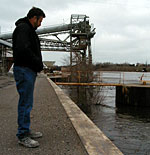Flood's Economic Impact Won't Disappear with the Water
By Andrew Haeg, Minnesota Public Radio
April 19 2001
Part of MPR's online coverage of the floods of 2001.
For the most part, communities along the Mississippi River have averted catastrophic flood damage, thanks in part to timely dike construction and sandbagging. State and federal offices are only now adding up the economic impact of the high waters, and one official estimates the bill from property damage alone will top $11 million. But that doesn't tell the full tale. Businesses that rely on the river to move raw materials or finished products are suffering.
SPRINGTIME IS NORMALLY a period of renewed vigor for riverside businesses. Ice thaws on Lake Pepin, and the barges that carry billions of dollars worth of products like fertilizer, steel, molasses and cement can again travel upriver.
Not this year, says Mark Schutz, terminal operator for Holnam Cement in Minneapolis, which gets cement from places like Korea, shipped through the gulf of Mexico.
"This year for the industry was a double whammy, because the ice wasn't out, so nobody got their product up here early. And then when the ice went out the river came up immediately. So you were hurt both ways here. We weren't able to fill up before the high water, and now we're waiting for high water to subside," Schutz says.
Last week, The Army Corps of Engineers closed a 400-mile stretch of the river south of the Twin Cities to all traffic.
Until the river subsides, Holnam and other businesses will have to find other ways to ship and receive their goods. When the Corps closed the river, Holnam started moving its cement upstream in trucks. But it takes 60 trucks to move what a single barge could. And that's a lot more expensive.
Army Corps officials in Gutenberg, Iowa estimate that barges carrying 2 million tons of cargo are stranded there, waiting for the river to recede before traveling upriver.
"The last episode that we'd really had that affected us in the same way was way back in 1969," says Kurt Norman, president of Hawkins Chemical, based in Minneapolis.
This time of year, Hawkins employees are usually unloading barges full of caustic soda, used to clean wastewater. Now, like Holnam Cement, Hawkins is shipping by rail and truck instead of barge.
Norman says it's the third time in 12 years he's had to manage through a major flood.
"Naturally we're concerned because it's things that are outside of the ordinary," he says. "There's extra expense that's being incurred for extra trucking to bring product here. And just the logistics of moving things around and making sure we've got things for people adds some burden. Fortunately, we've got great people that learned a lot the last two times out and have been able to transfer that knowledge throughout the whole organization."
Other riverside businesses are also hurting. Jerry Christianson is director of river services, in Minneapolis, a city-run business that transfers products like fertilizer or aggregate between barges and railcars.
He says he's had to lay off more than half of his 33 employees. If the river gets much higher, he'll have to lay off more. For him it's also the third time in 12 years he's taken such measures.
"It's a real problem, but it's a problem we're going to have to live with whenever we have hard winters like this," he says.
It will be some time before Christianson can call his employees back to work. Forecasters expect the Mississippi to remain swollen for weeks. And the Corps of Engineers says it won't be able to re-open the river for traffic until sometime in May.
By Andrew Haeg, Minnesota Public Radio
April 19 2001
Part of MPR's online coverage of the floods of 2001.
|
|
RealAudio |
| |
|
|
|
||
SPRINGTIME IS NORMALLY a period of renewed vigor for riverside businesses. Ice thaws on Lake Pepin, and the barges that carry billions of dollars worth of products like fertilizer, steel, molasses and cement can again travel upriver.
Not this year, says Mark Schutz, terminal operator for Holnam Cement in Minneapolis, which gets cement from places like Korea, shipped through the gulf of Mexico.
| |
|
|
|
||
Last week, The Army Corps of Engineers closed a 400-mile stretch of the river south of the Twin Cities to all traffic.
Until the river subsides, Holnam and other businesses will have to find other ways to ship and receive their goods. When the Corps closed the river, Holnam started moving its cement upstream in trucks. But it takes 60 trucks to move what a single barge could. And that's a lot more expensive.
Army Corps officials in Gutenberg, Iowa estimate that barges carrying 2 million tons of cargo are stranded there, waiting for the river to recede before traveling upriver.
"The last episode that we'd really had that affected us in the same way was way back in 1969," says Kurt Norman, president of Hawkins Chemical, based in Minneapolis.
This time of year, Hawkins employees are usually unloading barges full of caustic soda, used to clean wastewater. Now, like Holnam Cement, Hawkins is shipping by rail and truck instead of barge.
Norman says it's the third time in 12 years he's had to manage through a major flood.
| |
|
|
|
||
"Naturally we're concerned because it's things that are outside of the ordinary," he says. "There's extra expense that's being incurred for extra trucking to bring product here. And just the logistics of moving things around and making sure we've got things for people adds some burden. Fortunately, we've got great people that learned a lot the last two times out and have been able to transfer that knowledge throughout the whole organization."
Other riverside businesses are also hurting. Jerry Christianson is director of river services, in Minneapolis, a city-run business that transfers products like fertilizer or aggregate between barges and railcars.
He says he's had to lay off more than half of his 33 employees. If the river gets much higher, he'll have to lay off more. For him it's also the third time in 12 years he's taken such measures.
"It's a real problem, but it's a problem we're going to have to live with whenever we have hard winters like this," he says.
It will be some time before Christianson can call his employees back to work. Forecasters expect the Mississippi to remain swollen for weeks. And the Corps of Engineers says it won't be able to re-open the river for traffic until sometime in May.



